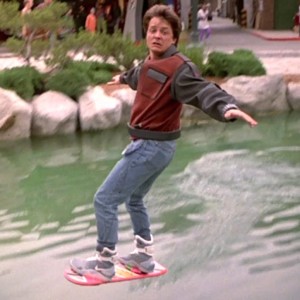We’ve been waiting for this for the last 30 years: Marty McFly and his time-traveling DeLorean have finally arrived in the future, October 2015.
So, how far have we actually come since the major motion picture “Back to the Future Part II” debuted? Is the present-day “future” filled with Pepsi Perfect, double-ties, and self-lacing shoes? Unfortunately for hoverboard enthusiasts, it looks like we still have a ways to go. But in many ways, our future is even better. In fact, the computing power of a single smartphone far outstrips the sum of all the computers that NASA owned during the 1969 moon landing.
Remarkably, the film got a number of predictions dead-on—we have voice-activated electronics, motion-sensing video games, and even dog-walking drones! The amusing part of this is that Robert Zemeckis, the director of “Back to the Future” wasn’t trying to accurately depict the future. He was coming up with the most outlandish ideas he could—especially the part about the Cubs winning the World Series!
Given that Zemeckis was trying to be facetious in his predictions, how did we actually arrive in a future without telephone booths? Mercatus Center scholar Adam Thierer lays it out in his book, “Permissionless Innovation.” Permissionless innovation is the idea that visionaries and inventors should generally be left free to experiment with new technologies and business models. It’s a simple but crucial idea, since we owe every innovation ever discovered to the pioneers who were willing to embrace the risk of trying something brand new.
Writer Virginia Postrel terms those who oppose this “stasists”—reactionaries who seek to prevent changes to the existing order, often because of a fear of the unknown. She identifies an unlikely coalition of cultural icons—pairing Pat Buchanan with Ralph Nader—that advocates for restraining ingenuity because, quite simply, the outcomes are beyond their control.
The problem with this overemphasis on precaution is that many of the most amazing things we have today initially looked like train wrecks waiting to happen. Steve Jobs’ push for the invention of the iPhone is a great example of this. What initially seemed to be a product that no one would want has turned into one of the most ubiquitous elements of modern life. A decade ago at his Stanford University commencement address Jobs proclaimed, “You can’t connect the dots looking forwards. You can only connect them looking backwards.”
Perhaps the most important thing to realize is that we don’t—and can’t—know what the future holds. Trying to guess the future—and direct it in a specific direction—makes the exact mistake that ruins the potential for unforeseen, amazing things. As Thierer notes, “living in constant fear of worst-case scenarios means that the best case scenarios will never come about.” We should trust in humanity’s most important trait—our amazing adaptability—and recognize that just as we’ve survived and even thrived our muddled way through history, we can do the same into the future.
As everyone knows, the first part of “Back to the Future” ends with Doc Brown’s iconic line: “Roads? Where we’re going, we don’t need … roads.” Despite the lack of flying cars, the future we’ve arrived in is even better than predicted—although Cubs fans might disagree! We can expect even greater things going forward, as long as we embrace the idea of permissionless innovation—which might even include hoverboards.

